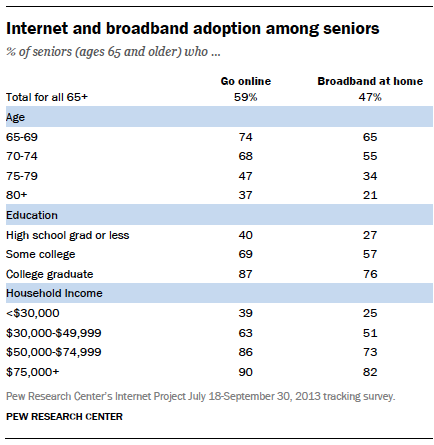In early April, the Pew Research Center released its latest report on Older Adults and Technology Use. The subhead for the report tells the tale: “Adoption is increasing, but many seniors remain isolated from digital life.” Indeed, the researchers identified two groups:
1) Younger, higher-income and more educated Americans over 65. These use the Internet at rates approaching or exceeding the general population. They feel positively about online tools and services.
2) Older, less affluent seniors, often with significant health/disability challenges. These elders are largely disconnected from online or mobile life.
For nearly a decade, Creating Results has started any presentation about older adults reminding audience members that it isn’t one “single, silver sea.” Behaviors and attitudes WITHIN generations can vary as widely as BETWEEN generations.
Here are four facts from the new Pew report that illustrate how colorful that sea of seniors is when it comes to the adoption/use of technology.
Disparities Seen by Education, Income, Health, Age

* 87% of seniors with a college degree go online. Only 40% of those who have not attended college go online.
Action Step: Web copy should be smart and respectful, not pretentious or pandering. And, not to be flip, but almost nothing turns off a highly-educated older adult more than poor spelling and grammar. Proofread those websites!
* 90% of seniors with higher incomes (annual household income of $75,000 or more) go online. 39% of those with household incomes of less than $30,000 go online. 63% of those with incomes between $30,000 and $49,999 are using Internet. According to data from the US Census Bureau, nationwide seniors are living off of a median household income of $35,107.
Action Step: Consider the income level of your ideal prospect when creating digital marketing budgets. If you’re serving a lower-income group, money spent on church flyers could go a lot further than money spent on online ads.
* Roughly 40% of Americans over 65 reported having a physical challenge. This could be anything from diminished eyesight that makes reading online difficult to a chronic disease. Only 49% of this group goes online, vs. 66% of all seniors.
Action Step: Conduct usability testing on websites to be sure important actions can be taken by all. Avoid tiny “submit” buttons!
* 74% of the “younger olds,” those aged 65-69, go online. 37% of those 80 or better are using the Internet.
Action Step: Look at your digital marketing through the eyes of a 65-69 year old target. Do they see themselves there? Do the photos feel authentic and representative of your customer’s self image?
Creating Results’ national Social, Silver Surfers study showed that a decreasing number of younger olds feel websites reflect their generation. Since we first measured attitudes in 2010, it appears expectations have risen and matures are feeling less represented on the web.

As we noted in the Social, Silver Surfers 2013 eBook, “if consumers don’t feel they see themselves in your marketing, they’re less likely to purchase your product or service.” (To buy the ebook and learn what steps to take, click here.)
Tomorrow we’ll share more data — and related action steps! — about older adults and technology.


